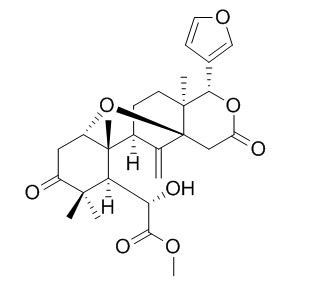Methyl 6-hydroxyangolensate
Methyl 6-hydroxyangolensate shows antifungal and antibacterial activities.
Inquire / Order:
manager@chemfaces.com
Technical Inquiries:
service@chemfaces.com
Tel:
+86-27-84237783
Fax:
+86-27-84254680
Address:
1 Building, No. 83, CheCheng Rd., Wuhan Economic and Technological Development Zone, Wuhan, Hubei 430056, PRC
Providing storage is as stated on the product vial and the vial is kept tightly sealed, the product can be stored for up to
24 months(2-8C).
Wherever possible, you should prepare and use solutions on the same day. However, if you need to make up stock solutions in advance, we recommend that you store the solution as aliquots in tightly sealed vials at -20C. Generally, these will be useable for up to two weeks. Before use, and prior to opening the vial we recommend that you allow your product to equilibrate to room temperature for at least 1 hour.
Need more advice on solubility, usage and handling? Please email to: service@chemfaces.com
The packaging of the product may have turned upside down during transportation, resulting in the natural compounds adhering to the neck or cap of the vial. take the vial out of its packaging and gently shake to let the compounds fall to the bottom of the vial. for liquid products, centrifuge at 200-500 RPM to gather the liquid at the bottom of the vial. try to avoid loss or contamination during handling.
Life Sci.2021, 270:119074.
J of the Korean Society of Cosmetics and Cosmetology2018, 399-406
Drug Des Devel Ther.2020, 14:969-976.
Front Plant Sci.2024, 15:1458916.
Bioorg Med Chem.2020, 28(12):115553.
Arch Toxicol.2024, 98(5):1415-1436.
Biomedicines.2020, 8(11):486.
J-STAGE2015, 249-255
ACS Pharmacol.Transl.Sci.2024, 4c00003.
Applied Biological Chemistry2022, 71:s13765-022-00743-5.
Related and Featured Products
Phytochemistry. 2013 Dec;96:312-7.
Rings B,D-seco limonoid antifeedants from Swietenia mahogani.[Pubmed:
24034555]
METHODS AND RESULTS:
Three phragmalin-type limonoids, swietephragmin H (1), swietephragmin I (2) and 11-hydroxyswietephragmin B (3), and a mexicanolide-type limonoid 2-hydroxy-6-deacetoxyswietenine (4), together with known compounds, 6-O-acetyl-2-hydroxyswietenin (5), 2-hydroxyswietenine (6), swietemahonin G (7), Methyl 6-hydroxyangolensate (8) and 7-deacetoxy-7-oxogedunin (9) were isolated from the leaves of Swietenia mahogani (Meliaceae). Their structures were established by extensive NMR experiments in conjunction with mass spectrometry.
CONCLUSIONS:
The antifeedant activity of the isolated compounds was evaluated.
Pest Manag Sci. 2005 Feb;61(2):186-90.
Antifungal activity of limonoids from Khaya ivorensis.[Pubmed:
15619711]
Chemical investigation of the diethyl ether extract of the stem bark of Khaya ivorensis A Chev (Meliaceae) afforded ten limonoids of angolensates, ring D-opened limonoids and mexicanolides.
METHODS AND RESULTS:
The structures of the limonoids isolated were determined by comparison of their (1)H and (13)C NMR data with those reported in the literature. These compounds were evaluated for their antifungal activity against the plant pathogenic fungus Botrytis cinerea Pers. Methyl 6-hydroxyangolensate and 3,7-dideacetylkhivorin were also tested for their antifungal and antibacterial activities on several fungal and bacterial species. Methyl angolensate and 1,3,7-trideacetylkhivorin displayed the highest antifungal activity against B. cinerea, with respectively 62.8 and 64.0% mycelial growth inhibition at 1000 mg litre(-1), and 73.3 and 68.6% mycelial growth inhibition at 1500 mg litre(-1).
CONCLUSIONS:
3,7-Dideacetylkhivorin showed stronger antifungal and antibacterial activities than Methyl 6-hydroxyangolensate against all of the test fungi and bacteria except Penicillium expansum Link. This is the first report on the antifungal and antibacterial effects of these limonoids. Structure-antifungal activity relationships of the limonoids isolated are discussed.



